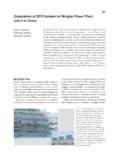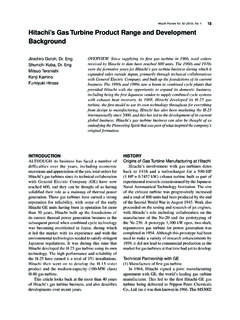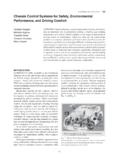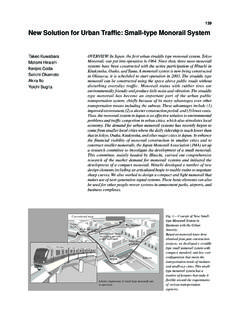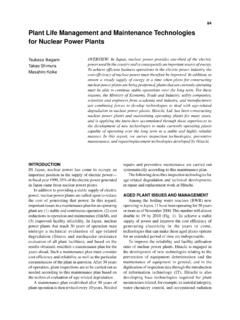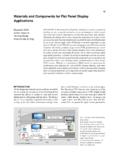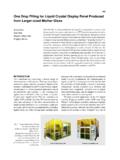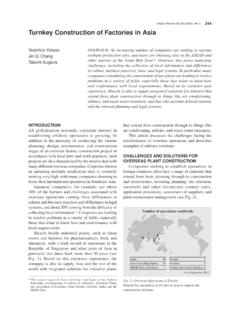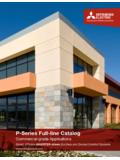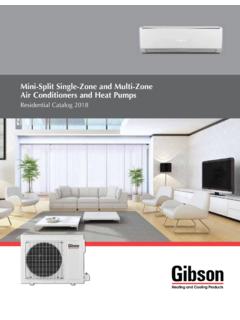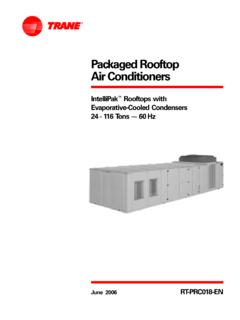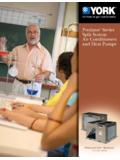Transcription of Air Conditioning Business in Brazil - Hitachi
1 Hitachi Review Vol. 58 (2009), No. 6 287 Cooling Air Conditioning Business in BrazilShigekichi KouchiyamaYoshikazu AmouMachio AmanoINTRODUCTIONCOMMON perceptions of the Federative Republic of Brazil in Japan include the carnival, the Amazonian jungle, and Japanese emigrants. Beyond this, however, popular knowledge of Brazil is often limited. The country has a land area of about million km2, which is 23 times larger than Japan, and a population of about 180 million. 2008 was the 100th anniversary of Japanese immigration into Brazil and it is estimated that about million people of Japanese descent now live Brazil has gained reputation recently as a member of the BRIC group of countries ( Brazil , Russia, India, and China), the attention it has received is perhaps less than that enjoyed by the other BRIC countries. Despite this, the Brazilian economy OVERVIEW: Air Conditioning in Brazil is primarily used for cooling and the demand is for products that offer low cost and high quality.
2 A shortage of foreign exchange after the oil crisis in the 1970s also led to a requirement for domestic production. In response, Hitachi Air Conditioning Products Brazil , Ltd. established domestic production of air conditioners at a local factory. This operation also survived the economic confusion associated with hyperinflation. The company has contributed to the growth of the air Conditioning Business in Brazil by supplying products with high performance and quality that utilize technology from Hitachi . Recent growth in the Business has been driven by a range of environmentally conscious products including the multi-split system air 1 Growth of Brazil and Air Conditioning cassette type indoor unit of packaged air conditioner (a), outdoor unit of packaged air conditioner (b), outdoor unit of the multi-split system air conditioner (c), and air-cooled water chilling unit (d). All of these models are made in Brazil .
3 The map shows the locations of the factory and the seven sales offices in Brazil and Argentina (e). The scenes from the energy carnival (f) and the financial district of S o Paulo (g) are shown. S o Paulo is a leading center in the growing Brazilian AiresPort AlegreRio de JaneiroFactory: S o Jos dos CamposS o PauloBrasiliaRecifeManaus(a)(c)(d)(e)(g) (f)(b)Air Conditioning Business in Brazil 288 has achieved consistent growth, much of it thanks to its natural resources, and its GDP (gross domestic product) of about 1,300 billion dollars in 2007 makes it the world s 10th largest Air Conditioning Products Brazil , Ltd. (HAPB) has been operating its air Conditioning Business in Brazil since 1972 (see Table 1). This article covers the history of the air Conditioning Business at HAPB and in doing so sheds some light on the nature of the Brazilian market and how to manage a Business in an emerging economy (see Fig.)
4 1).AIR Conditioning Business IN TURBULENT BRAZILIAN ECONOMYF oundation of Company Followed by Brazilian Economic Crisis HAPB constructed a factory in S o Jos dos Campos in 1973; one year after the company was established. The factory assembled packaged air conditioners using a knockdown production system (see Fig. 2). However, production started just as the first oil crisis hit, an event in 1973 that seriously affected the Brazilian economy because of its dependence on foreign finance. This was followed in the 1980s by a foreign debt crisis and hyperinflation which left the Brazilian economy in a critical situation. The government attempted numerous economic policies but inflation was not tamed until the Real Plan in 1994 which introduced a new currency and a fixed exchange rate (see Fig. 3).Amongst the severe measures adopted by the government during these times were import restrictions aimed at minimizing the outflow of foreign currency.
5 These measures remained in place until the market liberalization in 1990 and acted to protect and promote domestic Business and Growth in Economic CrisisHAPB had to manage its Business under the tough conditions that resulted from the economic confusion that reigned in Brazil in the period after the company was formed. These included restrictions on imports of parts, frequent changes in regulations, and hyperinflation. However, having its own Fig. 2 Full View of produces air Conditioning products in the city of S o Jos dos Campos in S o Paulo state. S o Jos dos Campos is one of Brazil s major industrial cities and also hosts factories run by General Motors Company (GM) and 3 Trend in Annual Inflation Rate in ranging between 15% and 80% during the 1970s, price inflation exceeded 100% in the early 1980s and surpassed 1,000% in the late 1980s. Inflation was finally brought under control by the Real Plan introduced in ,0002,5002,708%1994 Real Plan2,0001,5001,000197219751980198519901 995200020052008 YearInflation rate (IGP-DI/FGV)(%)5000 IGP-DI: general index of prices FGV: Foundation Getulio VargasTable 1.
6 Outline of HAPBHAPB has been producing and distributing air Conditioning products as a major supplier in Brazil since the company was established in : Hitachi Air Conditioning Products Brazil , and sale of commercial air conditionersSales territoryBrazil and Latin AmericaMain productsPackaged air conditioners , multi-split system air conditioners , water chilling units, and reciprocating compressorsFactoryS o Jos dos Campos (State of S o Paulo)Sales officesSix offices in Brazil (S o Paulo, etc.) and one office in ArgentinaNo. of employeesAbout 440 (about 360 in factory)Total salesAbout 13 billion yen (2007) Hitachi Review Vol. 58 (2009), No. 6 289 MULTI-SPLIT SYSTEM RANGE OF ENVIRONMENTALLY CONSCIOUS AND energy - efficient PRODUCTSM ulti-split System In-home Air ConditionersThe range of multi-split system air conditioners are a typical example of an environmentally conscious and highly efficient product. The multi-split system air conditioners consist of several indoor units connected to a single outdoor unit.
7 Each indoor unit can operate independently and the outdoor unit can save energy by adjusting its capacity in response to the air Conditioning load. Fig. 5 and Table 2 give an overview of the multi-split system air conditioner and its Japan, the multi-split system range of air local production facility meant that HAPB could expand domestic production of air conditioners and components such as compressors. As most of the competing air Conditioning suppliers in Brazil at that time were locally based manufacturers, the products and technology of HAPB earned a good reputation in the market. This domestic production also helped improve the design and production capabilities of HAPB and local suppliers ( piping and parts machining). The benefits of this experience now help HAPB develop products that meet the requirements of the local Procedures and Price Control during HyperinflationTo deal with the rapid change in asset values that occurred under hyperinflation, HAPB introduced the Currency Value Adjusting System accounting system in Brazil whereby accounting values were adjusted on a monthly basis.
8 To keep pace with inflation, product prices were also updated each month based on material price increases and changes in the inflation rate and interest rates. The level of complexity associated with such an accounting system led HAPB to introduce computer-based data processing to reduce clerical work. Above all, the critical factor in an inflationary economy is the ability to act of Air Conditioning Market and Era of CompetitionThe Brazilian economy gradually began to recover following market liberalization in 1990 and after inflation was brought under control by the Real Plan in 1994. Business has been expanding since 2003 thanks to higher prices of natural resources and the air Conditioning market has also been growing (see Fig. 4). At the same time, Brazil s currency, the real, has also appreciated during this advent of market liberalization brought increased activity by American manufacturers in the air Conditioning market.
9 The rising value of the real also encouraged growth in direct imports of air conditioners from Japanese suppliers and from cost-competitive Chinese and Korean manufacturers. This led to an increasingly competitive has responded with proactive measures aimed at supplying products suitable for the local market that take advantage of the company s local design and production capabilities combined with technology from 2. Features of Multi-Split System Air ConditionerThe advantages of multi-split system air conditioners include energy efficiency, easy equipment design and construction, and convenient efficiencyNo pump or duct fan required. Outdoor unit can adjust capacity to match air Conditioning indoor unit operates independently. Easy equipment design and constructionNo pump, water pipe, duct or duct fan operationEach indoor unit can be operated 4 Trend in Size and Growth of Brazilian Air Conditioning market size including room air conditioners is shown.
10 Increasing sales of small room air conditioners contributed to strong growth in recent size (1,000 refrigeration tons)Annual growth (%)2005 Market sizeAnnual growth200620072008-20-10010203040502,000 1,5001,0005000 Source: Brazilian Association of Refrigeration, Air Conditioning , Ventilation and HeatingAir Conditioning Business in Brazil 290 conditioners . However, this also brought greater advantage of its local factory, HAPB started domestic production of the multi-split system range of air conditioners in 2006 with the aim of shortening delivery times and reducing production costs. Another sales point that HAPB emphasizes with its customers is that service and maintenance are important considerations for complex products of this nature, and that HAPB has an existing service network in Brazil . In this way, the distinctive multi-split system range of air conditioners has grown to become the main product of HAPB (see Fig.)
